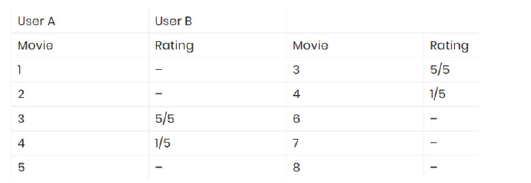- Submissions

Full Text
COJ Robotics & Artificial Intelligence
Movie Recommender Systems: Types and Modeling
Marappan R* and Sarveshvara Raja
Senior Assistant Professor, School of Computing, India
*Corresponding author: Marappan R, School of Computing, SASTRA Deemed University, Thanjavur, India
Submission: June 16, 2022;Published: September 27, 2022

ISSN:2832-4463 Volume2 Issue3
Abstract
Recommender systems are playing a major role in the information filtering to the users. Recently there are different recommender models developed for various artificial intelligence, machine learning and data analytics applications. This research focuses on the types of movie recommender systems and building a collaborative filtering model using Python.
Keywords: Recommender systems; Information filtering; Collaborative filtering; Machine learning; Data analytics; Artificial intelligences
Introduction
Recommender systems are filtering the required information to the users based on their
interests, styles of learning, and other primary characteristics. The recommender systems
such as Collaborative Filtering (CF) are also developed for movie applications [1,2]. The
recommendation systems are implemented by the companies for the following main criterion:
A. Improving the retention: The users choices are continuously catered to make loyal
customers
B. Increasing the sales: To increase the sales 10% to 50% due to accurate “You must
also like” recommendations of the products.
C. Form habits: To provide accuracy in the contents results in developing strong habits,
customers usage patterns.
D. Accelerate work: Time saving up to 80% due to specific recommendations and to
support the research work.
Types of Movie Recommender Systems
Figure 1:Types of movie recommenders.

The types of movie recommenders systems are sketched in (Figure 1) with CF and content-based filtering [3,4]. Companies such as Amazon, Pandora, and Netflix are using analytics to predict customer behaviors and provide recommendations. The companies such as Amazon, Pandora, Twitter, and Netflix track and how they use this data are sketched in (Figure 2-5).
Figure 2:Amazon recommender.

Figure 3:Pandora recommender.

Figure 4:Twitter recommender.

Figure 5:Netflix recommender.

Figure 6:CF & limitations.

Limitations of user CF
a. One can watch specific movies that no one else watches
which results in no recommendation.
b. Not enough ratings to match new movies.
c. For new users, the user is not rated and watched many
movies and it results in users mapping problems.
Building a user CF in python
The user CF model is developed in Python with the following
steps:
a. Install and import the surprise package.
b. Load the instance ml-100k.
c. Split the data into training and testing.
d. Apply the KNN algorithm to the training set.
e. Display the 25 best neighbors to the user with ratings.
f. Predict the rating for a user not yet watched the movie.
g. Find the expected ratings.
h. Test using the testing dataset for every movie.
The Python implementation is as follows: (Figure 7)
Figure 7:The Python implementation.

Conclusion & Future Work
This research analyzed the types of movie recommender systems and developed a CF model using Python for movie applications. In the future, different soft computing strategies can be used for the implementation to obtain better accuracy [5-10].
References
- Syed MA, Rakesh KL, Gopal KN, Rabindra KB (2018) Movie recommendation system using genome tags and content-based filtering. Advances in Data and Information Sciences, Springer, USA, pp. 85-94.
- Harper FM, Konstan JA (2015) The MovieLens datasets: History and context. ACM Trans Interact Intell Syst 5(4): 1-19.
- Bhaskaran S, Marappan R, Santhi B (2021) Design and analysis of a cluster-based intelligent hybrid recommendation system for e-learning applications. Mathematics 9(2): 1-21.
- Bhaskaran S, Marappan R, Santhi B (2020) Design and comparative analysis of new personalized recommender algorithms with specific features for large scale datasets. Mathematics 8(7): 1-27.
- Marappan R, Sethumadhavan G (2021) Solving graph coloring problem using divide and conquer-based turbulent particle swarm optimization. Arab J Sci Eng 47: 9695-9712.
- Marappan R, Sethumadhavan G (2020) Complexity analysis and stochastic convergence of some well-known evolutionary operators for solving graph coloring problem. Mathematics 8(3): 303.
- Marappan R, Sethumadhavan G (2018) Solution to graph coloring using genetic and tabu search procedures. Arab J Sci Eng 43: 525-542.
- Raja Marappan, Bhaskaran S, Aakaash N, Mathu Mitha S (2022) Analysis of COVID-19 prediction models: Design & analysis of new machine learning approach. Journal of Applied Mathematics and Computation 6(1): 121-126.
- Marappan R, Bhaskaran S (2022) Movie recommendation system modeling using machine learning. International Journal of Mathematical, Engineering, Biological and Applied Computing 1(1): 12-16.
- Raja Marappan, Bhaskaran S (2022) Datasets finders and best public datasets for machine learning and data science applications. COJ Rob Artificial Intel 2(1):
© 2022 Marappan R. This is an open access article distributed under the terms of the Creative Commons Attribution License , which permits unrestricted use, distribution, and build upon your work non-commercially.
 a Creative Commons Attribution 4.0 International License. Based on a work at www.crimsonpublishers.com.
Best viewed in
a Creative Commons Attribution 4.0 International License. Based on a work at www.crimsonpublishers.com.
Best viewed in 







.jpg)






























 Editorial Board Registrations
Editorial Board Registrations Submit your Article
Submit your Article Refer a Friend
Refer a Friend Advertise With Us
Advertise With Us
.jpg)






.jpg)














.bmp)
.jpg)
.png)
.jpg)










.jpg)






.png)

.png)



.png)






